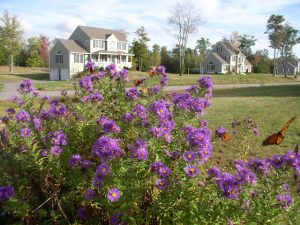Top 10 Native Plants from West Cook Wild Ones
West Cook Wild Ones has created the following list to help out anyone who is new to native plants and is unsure of where to begin their efforts. Below is a list of plants that we have found easy to grow (as long as they are sited correctly) and play multiple roles in the garden. Not every plant works for every gardener, and even native plants require some maintenance, such as periodic division, clearing unwanted seedlings (consider potting those up and giving to other who would like to start a garden; many schools would love to have these plants). Even though we love the following plants, its still a good idea to do a little research before adding them to your gardens to make sure they will work for you.
Top 10 Native Plants for Full Sun
1. Purple Coneflower (Echinacea purpurea): Starts to bloom at the beginning of July. Blooms are much beloved by all types of pollinators; birds love the seeds in the fall, and the leaves may host Gorgone Checkerspot and/or Silvery Checkerspot butterflies as well as some moth caterpillars (these also provide food for birds). Drought tolerant and adapts to most types of soils. Forms nice clumps.
2. New England Aster (Aster nova-angliae): Blooms later summer, provides fall nectar to pollinators. Monarchs love this plant and need it to fuel up for their long migration to Mexico. Leaves host the sweet little butterfly Pearl Crescentspot. Once New England Aster is established it can tolerate dry spells though generally this plant is listed as loving moister soils. The lower leaves tend to age and get brown. They are easy to swipe off, or just plant something a couple feet tall in front of them to hide their knees. They can also be pruned to a desired height before July 4. Its a really nice plant with a nice habit and beautiful purple flowers. There are many other kinds of wonderful asters, many of which volunteer themselves. Allow some of the volunteers to grow and enjoy their beautiful colors in the fall.

3. Wild Blue Indigo (Baptisia australis) (there are other baptisia species too offering white, cream, yellow flowers): Blooms in May, beautiful blue color, offering essential early nectar. The leaves host many species of butterflies (Sulphur, Wild Indigo Duskywing, Blues) . Over time develops a nice bush habitabout 4 feet high by 4 feet wide at maturity. Also offers wonderful winter interest.
4. Rose or Swamp Milkweed (Asclepias incarnata): Starts to bloom around Juneflowers will be covered by pollinators. Plants in the Asclepias genus are the only hosts for Monarch butterflies. Plant a milkweed of some type and you should get Monarch caterpillars. A. incarnata is a beautiful plantusually needs a moister site but can adapt to drier areas once established. A. sullivantii is Praire Milkweed and is suggested as a garden friendly version of Common Milkweed. It is not as aggressive.
5. Brown-eyed Susans (Rudbeckia species ): Blooms later in the summer and through the fall and sometimes even through the first snowfall. Drought tolerant, excellent nectar plant and host plant to checkerspot butterflies.
6. Downy Sunflower (Helianthus mollis): An attractive native sunflower, beneficial for pollinators, especially bees; birds eat the seeds, and it also hosts Gorgone and Silvery checkerspot butterflies (though we might not get those butterflies in our neighborhood) and moth caterpillars.
7. Bee Balm (Monarda fistulosa): Another favorite garden plant. Hosts a sphinx moth. Eventually, tall full stands are created. All pollinators love them (including Hummingbirds). Drawback is it can get Powdery Mildew.
8. Switch Grass (Panicum virginium): About 3-4 feet tall, beautiful foliage and seed heads. Food plant for several skippers, wildlife cover, and provides seeds for birds in the winter. Winter interest.
9. Prairie Dropseed (Sporobolus heterolepis): Beautiful and popular clump forming grassat home in formal designs as well as in the prairie. Wildlife cover and seeds; probably hosts skipper butterfly caterpillars.
10. Goldenrod (Solidago species): There are many kinds of Goldenrods to choose from, a couple we especially like are Stiff Goldenrod (Solidago rigida) and Showy Goldenrod (Solidago speciosa). Goldenrods are important fall nectar plants for pollinators and provide seeds in the fall. Leaves and flowers are used by many species of moths.
Just as a quick noteoften there can be some overlap between sun requirements. For instance, A. incarnata and Aster novae-angliae can tolerate some shade, and A. incarnata is tolerant of drier
conditions in part shade.
Please purchase your plants from reputable retailers such as Prairie Moon Nursery, Prairie Nursery, or from local nurseries that purchase their natives from responsible growers like Natural Garden Natives and Possibility Place. Their plants have been propagated from seed, not wild-dug which can further decimate populations of plants.
Be aware that sometimes plants offered for sale to support pollinators actually may have been treated by long-acting pesticides that may not outright kill the insects but can damage neurological and immune systems, ultimately causing their deaths. Avoid buying plants when the retailer cant guarantee that the plants have not been treated with pesticides.
Thank you for reading and considering sharing your yard for our fellow creatures and for our environment.
Reach us at https://westcook.wildones.org/ or on Facebookhttps://www.facebook.com/wildoneswestcook
